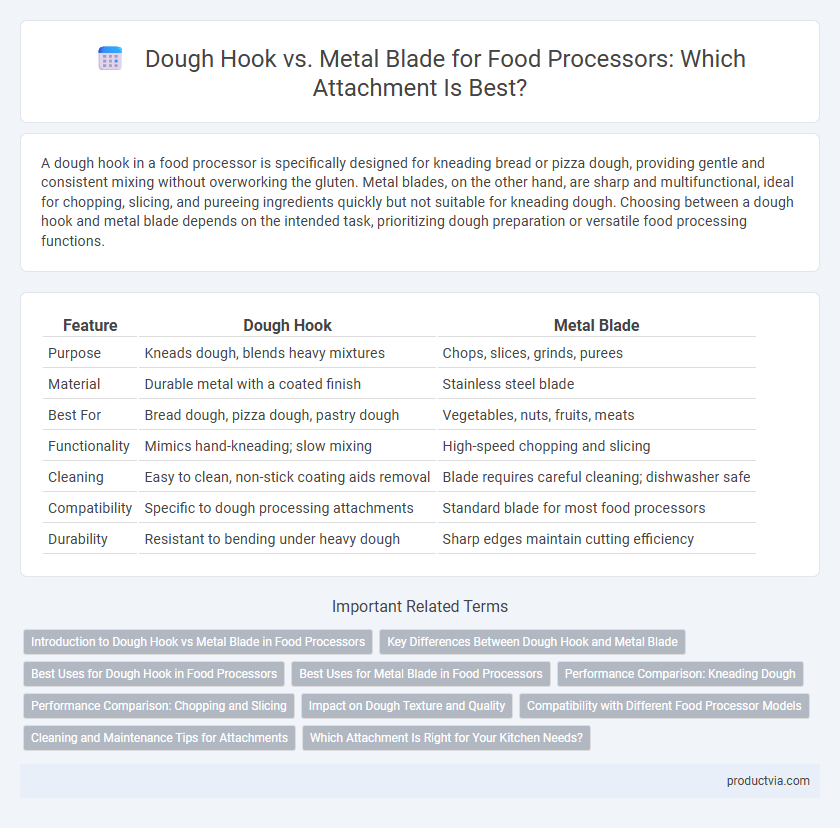A dough hook in a food processor is specifically designed for kneading bread or pizza dough, providing gentle and consistent mixing without overworking the gluten. Metal blades, on the other hand, are sharp and multifunctional, ideal for chopping, slicing, and pureeing ingredients quickly but not suitable for kneading dough. Choosing between a dough hook and metal blade depends on the intended task, prioritizing dough preparation or versatile food processing functions.
Table of Comparison
| Feature | Dough Hook | Metal Blade |
|---|---|---|
| Purpose | Kneads dough, blends heavy mixtures | Chops, slices, grinds, purees |
| Material | Durable metal with a coated finish | Stainless steel blade |
| Best For | Bread dough, pizza dough, pastry dough | Vegetables, nuts, fruits, meats |
| Functionality | Mimics hand-kneading; slow mixing | High-speed chopping and slicing |
| Cleaning | Easy to clean, non-stick coating aids removal | Blade requires careful cleaning; dishwasher safe |
| Compatibility | Specific to dough processing attachments | Standard blade for most food processors |
| Durability | Resistant to bending under heavy dough | Sharp edges maintain cutting efficiency |
Introduction to Dough Hook vs Metal Blade in Food Processors
Dough hooks and metal blades serve distinct functions in food processors, with dough hooks specifically designed to knead and mix heavy doughs, mimicking hand kneading for optimal gluten development. Metal blades excel in chopping, slicing, and pureeing, providing sharp, efficient cutting for a variety of ingredients. Choosing between a dough hook and a metal blade depends on the food preparation tasks, with dough hooks ideal for baking applications and metal blades suited for general food processing needs.
Key Differences Between Dough Hook and Metal Blade
The dough hook in a food processor is specifically designed for kneading dough, featuring a spiral or hook shape that mimics hand-kneading to develop gluten efficiently. In contrast, the metal blade is a multi-purpose component made of stainless steel, ideal for chopping, slicing, and pureeing ingredients with sharp, flat edges. Key differences include the dough hook's gentle, folding motion suited for dough texture versus the metal blade's high-speed, cutting action perfect for food preparation tasks beyond dough handling.
Best Uses for Dough Hook in Food Processors
The dough hook in food processors is specifically designed for kneading bread or pizza dough, efficiently developing gluten and saving time compared to hand kneading. Unlike metal blades, which are optimal for chopping, slicing, and pureeing, dough hooks provide gentle, consistent mixing ideal for yeast-based doughs. Using a dough hook ensures evenly mixed dough with improved texture, making it the best choice for baking applications requiring thorough kneading.
Best Uses for Metal Blade in Food Processors
Metal blades in food processors excel at chopping, slicing, and pureeing a variety of ingredients, making them ideal for preparing vegetables, nuts, and fruits with precision. Their sharp, durable edges effortlessly handle tougher tasks such as grinding meat and shredding cheese, providing consistent texture and speed. Unlike dough hooks designed specifically for kneading, metal blades offer versatile performance for general food prep, maximizing efficiency in everyday cooking and baking tasks.
Performance Comparison: Kneading Dough
The dough hook excels at kneading dough by mimicking hand-kneading movements, resulting in smoother, more elastic dough with less effort. In contrast, a metal blade can chop and mix ingredients quickly but often lacks the slow, consistent motion needed for proper gluten development in dough. For optimal performance in kneading, the dough hook ensures better texture and structure compared to the rapid, cutting action of a metal blade.
Performance Comparison: Chopping and Slicing
Dough hooks and metal blades in food processors serve distinct purposes, with metal blades excelling in chopping and slicing tasks due to their sharp, durable edges designed for precise cuts and quick processing. Dough hooks, while effective for mixing and kneading dough, lack the sharpness needed for clean chopping or slicing, resulting in uneven textures when used for these purposes. For optimal performance in chopping and slicing, metal blades provide superior efficiency and consistency compared to dough hooks.
Impact on Dough Texture and Quality
Dough hooks in food processors gently knead dough, preserving gluten structure and resulting in a tender, elastic texture ideal for bread and pastries. Metal blades, designed primarily for chopping and mixing, can overwork the dough, causing excessive gluten development and resulting in a tougher, denser crumb. Choosing the correct attachment directly impacts dough consistency and final baked product quality.
Compatibility with Different Food Processor Models
Dough hooks are typically designed for specific food processor models with dedicated attachment points, ensuring precise compatibility and optimal performance during dough kneading. Metal blades, on the other hand, offer broader compatibility across various food processor brands and models, making them versatile for chopping, slicing, and mixing tasks. Checking the manufacturer's specifications is crucial to confirm whether the dough hook or metal blade securely fits your particular food processor model.
Cleaning and Maintenance Tips for Attachments
Dough hooks, typically coated with non-stick materials, require gentle hand washing to prevent damage and maintain their coating, while metal blades are often dishwasher safe but must be dried immediately to avoid rust. Regularly removing food residue from both attachments prevents buildup and ensures optimal performance. Lubricating moving parts and storing attachments in a dry place prolongs their lifespan and maintains hygiene.
Which Attachment Is Right for Your Kitchen Needs?
Choosing between a dough hook and a metal blade for your food processor depends on your culinary priorities and typical recipes. Dough hooks excel at kneading bread or pizza dough, providing consistent texture without overworking the gluten, while metal blades efficiently chop, puree, and shred a wide range of ingredients, making them ideal for general food prep. Consider your cooking habits: opt for the dough hook if you often bake yeast-based goods, whereas the metal blade suits versatile chopping and blending tasks.
Dough hook vs Metal blade for food processor Infographic

 productvia.com
productvia.com